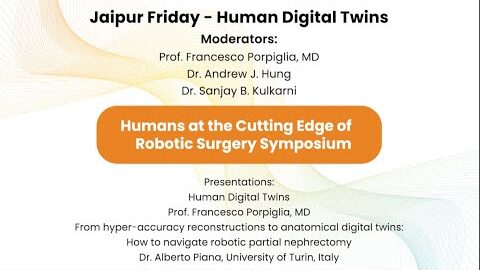#196 3D augmented reality RA segmental ureterectomy with buccal mucosa graft… Dr. Alberto Piana
This is one of the 2023 KS International Innovation Awards videos selected for inclusion in the Vattikuti Foundation – ORSI Humans on the Cutting Edge of Robotic Surgery Conference, October 6, 7 & 8, 2023 in Ghent, Belgium. Posting does not imply that is has been selected as a Finalist, just that the content will be discussed at the Conference.
From the entry: Full Title: 3D augmented reality robotic-assisted segmental ureterectomy with buccal mucosa graft for the repair of upper complex ureteral strictures
A. Piana, D. Amparore, G. Busacca, P. Alessio, E. Checcucci, F. Piramide, S. De Cillis, G. Volpi, P. Verri, M. Sica, M. Burgio, A. Bellin, M. Di Dio, M. Manfredi, C. Fiori, F. Porpiglia
Department of Urology, ‘‘San Luigi Gonzaga’’ Hospital, University of Turin, Turin, Italy
Background Ureteral stenosis constitutes a very complex surgical scenario with a high rate of post-operative failure. For 2-3 cm upper stenosis, a segmental ureteral resection with uretero-ureteral anastomosis using a buccal mucosa graft is a fesible option. In order to increase the precision in locating the stricture during the surgical dissection of the ureter, we tested 3D augmented reality (AR) surgical navigation during the intervention.
Materials and Methods AR intraoperative navigation is performed using a dedicated ICON rack connected to the DaVinci® surgical console. The surgeon can visualize the superimposed images in real time. Three cases of different level ureteral strictures caused by stones embedded into the ureteral wall and located above the iliac vessels cross are shown in the video. AR is used to superimpose the 3D virtual model of the ureter together with its stone over the operative field, leading to a precise location and resection of the stricture. In the reconstructive phase, the mucosal graft is put into the abdominal cavity once the posterior plate of the anastomosis is realized, minimizing the tension on the defect repair.
Results In the three cases, AR allowed a proper identification of the endoluminal stricture. Postoperative examinations confirmed the success of the procedures.
Conclusions Augmented reality intraoperative guidance showed to be a useful technological tool able to correctly identify the ureteral stricture, leading to maximize the preservation of ureteral peri-strictural healthy tissue.
See more at: https://vattikutifoundation.com/videos/
Date
August 15, 2020






